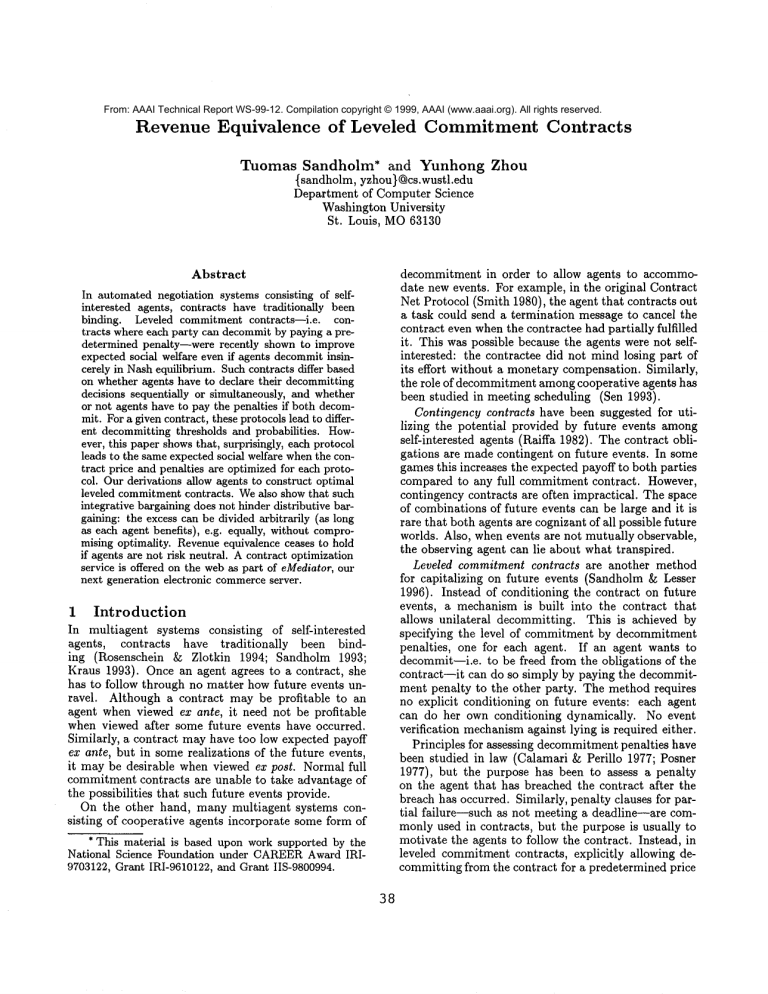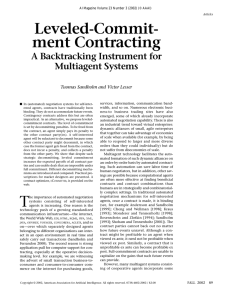
From: AAAI Technical Report WS-99-12. Compilation copyright © 1999, AAAI (www.aaai.org). All rights reserved.
Revenue Equivalence
Tuomas
of Leveled
Commitment Contracts
Sandholm*
and Yunhong Zhou
{sandholm, yzhou)@cs.wustl.edu
Department of ComputerScience
WashingtonUniversity
St. Louis, MO63130
Abstract
In automatednegotiation systemsconsisting of selfinterested agents, contracts havetraditionally been
binding. Leveled commitment
contracts--i.e, contracts whereeach party can decommit
by payinga predeterminedpenalty--wererecently shownto improve
expectedsocial welfareevenif agentsrecommitinsincerely in Nashequilibrium.Suchcontractsdiffer based
on whetheragents haveto declare their decommitting
decisions sequentially or simultaneously,and whether
or not agentshaveto paythe penalties if both recommit. Fora givencontract,these protocolslead to different decommittingthresholds and probabilities. However, this papershowsthat, surprisingly,eachprotocol
leads to the sameexpectedsocial welfarewhenthe contract price andpenalties are optimizedfor eachprotocol. Ourderivationsallow agentsto construct optimal
leveled commitment
contracts. Wealso showthat such
integrativebargainingdoesnot hinderdistributivebargaining:the excesscan be dividedarbitrarily (as long
as each agentbenefits), e.g. equally, withoutcompromisingoptimality. Revenueequivalenceceases to hold
if agentsare not risk neutral. Acontract optimization
service is offeredon the webas part of eMediator,our
next generationelectronic commerce
server.
decommitmentin order to allow agents to accommodate newevents. For example,in the original Contract
Net Protocol (Smith1980), the agent that contracts out
a task could send a termination messageto cancel the
contract evenwhenthe contractee hadpartially fulfilled
it. This was possible becausethe agents werenot selfinterested: the contractee did not mind losing part of
its effort without a monetarycompensation.Similarly,
the role of decommitment
amongcooperative agents has
been studied in meeting scheduling (Sen 1993).
Contingencycontracts have been suggested for utilizing the potential provided by future events among
self-interested agents (Raiffa 1982). Thecontract obligations are madecontingent on future events. In some
gamesthis increases the expectedpayoffto both parties
comparedto any full commitmentcontract. However,
contingencycontracts are often impractical. Thespace
of combinationsof future events can be large and it is
rare that both agents are cognizantof all possible future
worlds. Also, whenevents are not mutuallyobservable,
the observing agent can lie about what transpired.
Leveled commitmentcontracts are another method
for capitalizing on future events (Sandholm& Lesser
1996). Instead of conditioning the contract on future
events, a mechanismis built into the contract that
allows unilateral decommitting. This is achieved by
specifying the level of commitmentby decommitment
penalties, one for each agent. If an agent wants to
decommit--i.e, to be freed from the obligations of the
contract--it can do so simply by paying the decommitmentpenalty to the other party. The methodrequires
no explicit conditioning on future events: each agent
can do her ownconditioning dynamically. No event
verification mechanism
against lying is required either.
Principles for assessing decommitment
penalties have
been studied in law (Calamari & Perillo 1977; Posner
1977), but the purpose has been to assess a penalty
on the agent that has breachedthe contract after the
breach has occurred. Similarly, penalty clauses for partial failure--such as not meetinga deadline--are commonlyused in contracts, but the purposeis usually to
motivate the agents to follow the contract. Instead, in
leveled commitment
contracts, explicitly allowing decommittingfrom the contract for a predeterminedprice
1 Introduction
In multiagent systems consisting of self-interested
agents, contracts have traditionally
been binding (Rosenschein & Zlotkin 1994; Sandholm 1993;
Kraus 1993). Oncean agent agrees to a contract, she
has to follow through no matter howfuture events unravel. Although a contract maybe profitable to an
agent whenviewedex ante, it need not be profitable
whenviewed after somefuture events have occurred.
Similarly, a contract mayhave too low expected payoff
ex ante, but in somerealizations of the future events,
it maybe desirable whenviewedex post. Normalfull
commitmentcontracts are unable to take advantage of
the possibilities that such future events provide.
On the other hand, many multiagent systems consisting of cooperative agents incorporate someform of
* This material is based uponworksupported by the
National Science Foundation under CAREER
AwardIRI9703122,GrantIRI-9610122,and Grant IIS-9800994.
38
sults for the agents? Section 3 showsthat, surprisingly,
each protocol leads to the same expected social welfare
when the contract price and penalties are optimized for
each protocol. Section 4 analyzes the interplay between
integrative and distributive bargaining in leveled commitment contracting, and shows how to construct a fair
optimal contract. Section 5 discusses nonuniqueness.
Section 6 shows that revenue equivalence ceases to hold
if agents are not risk neutral. Section 7 concludes.
is used as an active methodfor utilizing the potential
provided by an uncertain future. 1 The decommitment
possibility increases each agent’s expected payoff under
very general assumptions (Sandholm & Lesser 1996).
This paper studies the same setting and the same contract types as they did, but derives new results.
Weanalyze contracting situations from the perspective of two risk neutral agents who attempt to maximize
their own expected payoff: the contractor who pays to
get a task done, and the contractee who gets paid for
handling the task. Handling a task can mean taking on
any types of constraints. The methodis not specific to
classical task allocation. The contractor tries to minimize the contract price p that he has to pay. The contractee tries to maximizethe payoff p that she receives.
The future of the agents involves uncertainty. Specifically, the agents might receive outside offers? The contractor’s best outside offer 5 is only probabilistically
knownex ante by both agents, and is characterized by
a probability density function f(5). If the contractor
does not receive an outside offer, 5 corresponds to its
best outstanding outside offer or its fall-back payoff, i.e.
payoff that it receives if no contract is made. The contractee’s best outside offer b is also only probabilistically
knownex ante, and is characterized by a probability
density function g(b). If the contractee does not receive
an outside offer, b corresponds to its best outstanding
outside offer or its fall-back payoff. 3 The variables 5
and b are assumed statistically
independent.
The contractor’s options are either to makea contract
with the contractee or to wait for ~. Similarly, the contractee’s options are either to makea contract with the
contractor or to wait for b. The two agents could make a
full commitmentcontract at some price. Alternatively,
they can make a leveled commitment contract which
is specified by the contract price, p, the contractor’s
decommitmentpenalty, a, and the contractee’s decommitment penalty, b. The contractor has to decide on
decommitting when he knows his outside offer ~ but
does not know the contractee’s outside offer b. Similarly, the contractee has to decide on decommitting
when she knows her outside offer b but does not know
the contractor’s. This seems realistic from a practical
automated contracting perspective.
Section 2 reviews the leveled commitmentcontracting
protocols and how rational agents decommit in them.
The question arises: which protocol leads to the best re-
2
Leveled
commitment
contracts
One concern with leveled commitmentcontracts is that
a rational agent is reluctant to decommitbecause there
is a chance that the other party will decommit,in which
case the former agent gets freed from the contract,
does not have to pay a penalty, and collects a penalty
from the breacher. (Sandholm ~ Lesser 1996) showed
that despite such insincere decommitting the leveled
commitmentfeature increases each contract party’s expected payoff, and enables contracts in settings where
no full commitmentcontract is beneficial to all parties.
Wederive the Nash equilibrium (Nash 1950b) where
each agent’s decommitting strategy is a best response
to the other agent’s decommitting strategy. The results
of the paper take into account the fact that agents decommitinsincerely in this way.
2.1
Sequential
decommitting
(SEQD)
In a sequential decommitting (SEQD)game, one agent
has to declare her decommitting decision before the
other. Weassume that the contractee has to decommit first. The case where the contractor has to go first
is analogous. There are two alternative types of leveled
decommitment contracts based on whether or not the
agents have to pay the penalties if both decommit.
If the contractee has decommitted, the contractor’s
best move is not to decommit because -5 - a + b <
-5 + b (unless a < 0, which would mean--absurdly-that the contractor gets paid for decommitting). This
also holds for a contract where neither agent has to
pay a decommitment penalty if both decommit since
-5 _< -5 + b. In the subgame where the contractee
has not decommitted, the contractor’s best move is to
decommit if-5-a > -p, i.e. the contractor decommits
if his outside offer, 5, is belowa threshold 5* = p-a. So,
the probability that he decommitsis Pa = f~_~ f(5)da.
1Decommittinghas been studied in other settings, e.g.
where there is a constant inflow of agents, and they have
a time cost for searching partners of two types: good or
bad (Diamond & Maskin 1979).
2The frameworkcan also be interpreted to model situations wherethe agents’ cost structures for handling tasks
and for getting tasks handled change e.g. due to resources
going off-line or becomingback on-line.
3Gameswhereat least one agent’s future is certain, are
a subset of these games.In such gamesall of the probability
mass of f(~) and/or g(~) is on one point.
The contractee gets b - b if she decommits, b + a if
she does not but the contractor does, and p if neither
decommits. Thus the contractee decommits if b - b >
pa(b+a)+(1-pa)p. A contract where Pa = 1 cannot be
strictly individually rational to both agents since breach
will occur for sure. On the other hand, when pa < 1 the
inequality above shows that the contractee decommitsif
her outside offer exceeds a threshold b* = p-t- 1-pa
b+ap,
" So,
=
the probability that she decommitsis Pb f~. g(b)db.
39
The rest of the paper uses the following shorthand:
£
E(5)
E(5,5")
- 5f(5)d~,
E(b)
co
_=/_ 5f(5)dh,
£
--
bg(b)db
£
E(5*, 5) - r~f(~)d~
co
f,.
E(~,,P) - f ~,g(g)e~,
The contractor’s expected payoffunder the contract is
f
~o=pb (-5 + Of(5)e5+ (1 - pb).
----pb[b -- E(5)] (1-pb)[-E(5, 5" ) - apa - p(1-pa)]
= -[pa(1- pb)o- pbb+ (1 - Pc)0- pb)p]
-E(5) (1- pb)E(5*, 5)
= -E(5) - ¢(p,a,b) + (1-- pb)E(5*
2.2
co
[/:
,~o -pb (-~ + b - a)I(~)d5
+(1 - Pb)
~;*
Is:;
(--5--
a)f(5)d5
/:.(-5 + b/f(5)d~
]
z ]
+ . (-p)f(5)d5
=Phi--E(5, 5") + (b - a)pa b(1 - Pa) -- E(5*, 5)]
+(1 - Pb) [-S(5, 5*) apa - p(~ - Pa)]
b)d~ +/_g(~)[pa(b + (1-p a)p)]db
=-[p.,~- pbb+ p(1- p.)O- pb)]
= --pbb+ (1--pb)(paa+ (1--Pa)p)+E(b*, b)+paE(b,
= [pa(1 - pb)a -- pbb + (1 -- pa)(1 Pb)p]
+E(b) - (1 - p,)E(b, b*)
-E(5) + (1 - pb)E(5*,
--E(5) -- ¢(p, a, b) (1- pb)E(5*, 5), where
= E(b) + ¢(p, a, b) - (1 pa)E(b, b*
The expected social welfare under the contract is
pay
In our simultaneous decommitting games, agents have
to reveal their decommitmentdecisions simultaneously.
Wefirst discuss the SIMUDBP
variant where both have
to pay the penalties if both decommit. The contractor
decommits ifpb. (-~+b- o)+(1-pb)(-5- a) > pb"
b) + (1 -Pb)(--P). A contract where Pb = 1 cannot be
strictly individually rational to both agents since breach
will occur for sure. If pb < i the inequality above shows
that the contractor decommitsif his outside ~qffer is less
than a threshold ~* = p- lapb. So, Pa = fa_ccf(5)da.
The contractee decommits if (1 -pa)(b - b)+ Pa(b
b+a) > (1-pa)p+pa(b+a).
A contract where Pa = 1
cannot be strictly individually rational to both agents
since breach will occur for sure. If Pa < 1 the inequality
shows that the contractee decommitsif her outside offer
exceeds a threshold b* = p + l_~bp. So, Pb = fit g(~)di
The contractor’s expected payoff under the contract is
where¢(p, a, b) = pa(1 pb)a -- pbb+ (1-- pa)(1 Pb)P.
The contractee’s expected payoff under the contract is
?rb--~.g(b)(~-
Simultaneous
deeommitting,
both
if both decommit
(SIMUDBP)
¢(p, a, b) = paa - pbb p(1 -- pa)(1 -- Pb)
The contractee’s expected payoff under the contract is
~--- 71"a + 7rb
"fib = Pa ¯ g(b)(b-
-- E(b) - E(5) (1- pb)E(5*, 5) (1 -- pa)E(b, b*)
b + a)db
=#aUbock
+ U(a*,P),
+(1 -pa)
where 7rfaltbaet~ = E(b) - E(5) is the expected social
welfare that wouldprevail without the contract (i.e. expected welfare from the outside offers), and the excess
[/: I::
. g(b)(t)-
= pa[E(b*,b) +pb(a - b) + E(b,b*) (1--p b)a]
+(1- po)[E(~,*,
~,) - pbb
+p(1=
The contractor’s individual rationality
(IR) constraint states that he will participate in the contract
only if that gives him higher expected payoff than waiting for the outside offer:
-’-E(b) + ¢(p, o, b) - (1 pa)E(b, b*
The expected social welfare under the contract is
71"a b--{- 71"
7ra > -E(~) ~=~¢(p, a, b) _ (1 pb)E(5*, ~)
E(b) - E(5) + (1-pb)E(~*, (1- pa)E(t), b’)
#ou~a~
+ H(~*,~*),
Similarly, the contractee’s IR constraint is
~rb > E(b) ¢~ (1 pa)E(b, b*) _<¢(p, a, b).
[paa--pbb+p(1--pa)(1--pb)]
+E(b) - (1 pa)E(b, b*
where 7r.talmack and H(x, y) are defined as in Sec. 2.1.
4O
Simultaneous
decommitting,
neither
pays if both decommit
(SIMUDNP)
In a simultaneous
decommitting game where neither agent has to pay the penalty if both decommit
(SIMUDNP),
the contractor decommitsif Pb" (-- ~) + (1-pb)(--~t -- a) > Pb " (--~t + b) (1- Pb)(--P). A contract
where Pb -- 1 cannot be strictly individually rational
to both agents since breach will occur for sure. When
Pb < 1 the inequality above shows that the contractor
decommitsif his outside offer i.s less than a threshold
~* = p - a - l?pb. SO, Pa : ~oo f(5)da.
tion we show that if the contract price and the decommitting penalties are optimized for each game
(SEQD, SIMUDBP,or SIMUDNP)separately,
each
the games leads to the same expected social welfare.
This is surprising since the optimal contracts differ for
the games. Also, for a given suboptimal contract, the
decommitting thresholds, decommitting probabilities,
and expected welfare generally differ across the games.
We start by showing that if a leveled commitment
contract can generate positive excess, H, i.e. it can
lead to higher expected social welfare than making no
contract and waiting for the outside offers, then an unconstrained optimum exists.
Lemma1 Let f and g be probability distributions
on
(-c¢, cx)) with finite expectations.
2.3
The contractee decommits if (1 -Pa)(b - b) + Pab
(1-pa)p+pa (b+a). A contract where Pa = 1 cannot be
strictly individually rational to both agents since breach
will occur for sure. Ifpa < 1 the inequality above shows
that the contractee decommits if her outside offer w exv
ceeds a threshold b*= ~_v-~-h- ~l_pa" So, Pb = f~. g(b)db.
The contractor’s expected payoff under the contract is
=
y ~ ~ oo
oo
If maxx,yH(x, y) > O, then there exists a global maximal point (a*, b*) of H that satisfies
+ (-5 + b)f@db
a* fb~ bg(b)db
px:’?
~ J--oo
a~
~
f(U)dS,
~b=
g()dS.
*
The proofs are highly nontrivial. They are omitted
due to the space limitation, but they can be found in
an extended technical report (Sandholm & Zhou 1999).
Nowwe are ready to present the main result (its proof
uses Lemma1):
Theorem 1 Let f and g have finite expectations. If
an expected social welfare maximizing IR leveled commitment contract is chosen for each of the protocols
(SEQD, SIMUDBP, and SIMUDNP)separately,
each
protocol yields the same expected social welfare. The
pairs (possibly multiple per protocol) of decommitting
thresholds and the associated decommitting probabilities
will also be the same. The optimal contract may differ
for the different protocols, but in each protocol the optimal decommitment penalties ave nonnegative.
¢(p, a, b) pa(1 -- pb)a --(1 --pa)pbb +p(1-- p,) (1 --Pb
The contractee’s expected payoff under the contract is
= Pa ¯ g(b)bdb+
b* fa~ 5f(5)d5
Specifically,
H(a*, b*) = maxH(x, y) (b *-a*)(1-p~)(1-py) wh
= pb[--E(5, a*) + b(1 Pa) - E(~*, 5)
+(1 -- pb)[--E(5, 5*) -- apap(1-- Pa)]
-----[pa(l
--pb)a--(i--pa)pbb
+ p(l- pa)(l
Pb)
-E(~) + (1 pb)E(~*, 5)
= -E(5) - ¢(p, a, b) (I- pb)E(5*, 5), wher
~rb
y~ ~
+a)g(b)db
+(i - pa) . g(~)(~-b)d~+ pg(~)d~
= pa[E(b*,b) E(b,b*) + (i--p b)a]
+(1 - pa)[E(b*, b) pbb + p(1 - Pb)]
= [pa(1--pb)a -- (1--pa)pbb + p(1--pa)(1--pb)]
TE(b) (i- pa)E(b, l)*
-= E(b) + ¢(p, a, b) (i- pa)E(b, b*)
3.1
Existence of optimal IR contracts
It turns out that if some leveled commitmentcontract
generates positive excess to the agents in the aggregate,
then there exists an optimal leveled commitmentcontract that generates positive excess to each agent, i.e.
the contract is agreeable in the sense of individual rationality. More strongly:
Proposition
1 Let f and g have finite
expectations.
For SEQD, SIMUDBP, and SIMUDNP,
max~,y H(x, y) > 0 iff there exists an expected social
welfare maximizingcontract (p, a, b) that is IR for both
agents.
The expected social welfare under the contract is
~r ---- 71"a -{- ~b
= E(b) - E(~) + (1 pb)E(5*, ~) (1 - pa)E(b, b*)
= =1al~b~ck
+ H(~*,~*),
where 7rJallback and H(x, y) are defined as in Sec. 2.1.
3 Revenue
equivalence
Now, which of the leveled commitment contracting
protocols would be best for the agents? In this sec41
Based on this result, throughout the rest of the paper
we assume that max~,~ H(x, y) > 0. Recall that
denote an optimal (x, y) by (a*, b*).
SIMUDNP),eaeb is maximized iff the contract maximizes expected social welfare and ea = eb. Such a contract alwaysexists.
4 Integrative
5
vs. distributive
bargaining
Proposition 1 showed that among optimal contracts
there are ones that are beneficial for both parties. However, the question of how to divide the excess between
the agents remains, i.e. how to choose amongthe individually rational contracts. Each agent’s excess is her
expected payoff under the contract minus the expected
fallback payoff: ea = ~ra - ~r~auback = ~ra + E(~) and
fallback
--- 7rb -- E(b). It is conceivable that
beb -~ ~rb -- 7r
in leveled commitmentcontracts there is a tradeoff between integrative bargaining (maximizing the expected
social welfare) and distributive bargaining (splitting the
excess between the agents). It could be that somesplits
cannot be supported by an optimal contract. However,
it turns out that any individually rational split can be
supported by an optimal contract:
Proposition 2 Let f and g have finite expectations.
For each one of the games (SEQD, SIMUDBP, and
SIMUDNP),for any given fl ¯ [0, 1] there exists an
expected social welfare maximizing contract where ea fig(a*, b*), and eb = (1 -- fl)g(a*, b*).
Since the agents would only agree to individually rational splits anyway, Proposition 2 means that for all
practical purposes, integrative and distributive bargaining do not hinder each other in leveled commitmentcontracts. Of course, the contract has to be chosen carefully. First p should be chosen (in the IR range) which
determines the distributive part. Then the penalties, a
and b, are calculated based on p in order to maximize
expected social welfare. Choosing the penalties first
does not allow the same separation of integrative and
distributive bargaining because once a and b are fixed,
the choice of p is limited if one wants to construct an
expected social welfare maximizing contract.
Nonuniqueness
Usually the excess, H(x, y), has a unique global maximum, but not always. Let (x0, Y0) be a global maximum. If f(x) = 0 in some neighborhood of x0 and
g(y) = in a n eighborhood of Y0,ther e exis ts a ne ighborhood of (x0, y0) in which all (x, y) maximizeH(x,
The excess, H(x, y), can also have multiple global
maxima that are not in the same neighborhood. In
particular, the pair (a*, b*) determined in Lemma1
not always unique. The following example shows a case
with 3 local maximaof which 2 are globally maximal.
f(x) = 1/10 if 0 < x < 10, and 0 otherwise.
g(y) =
117/3520
42939/165440
0
if 0 _< y <32o
~if ~ _< y_< 10
otherwise.
We use Lemma1 to find all local maxima. Because
f(x) > 0 and g(y) > 0 for all x,y ¯ [0, 10], each local maximum(x, y) must satisfy the mutual equations
($). The first of those equations can be reduced
y = (10 q- x)/2, i.e, x = 2y - 10. For the second one,
the cases y < y0 and y > y0 have to be treated separately. For each case, the mutual equations are solved
to find (x, y). The solutions, i.e. the local maxima,are
(10/3,20/3), (4,7), and (5, 15/2). The excess
are H(10/3,20/3) = H(5, 15/2) = 1-~2, H(4,7)
Since 27/55 < 65/132, both (10/3, 20]3) and (5, 15/2)
are global maxima,(4, 7) is only a local maximum.
Nonuniqueness of the optimal threshold pair--and
the associated nonuniqueness of the optimal contract
(p, a, b)--does not prevent the use of leveled commitment contracts. To maximize expected social welfare,
the agents can pick any one of the optimal contracts.
4.1
Fair optimal contracts
Proposition 2 implies that there is no tradeoff between
expected social welfare maximization and fairness (aka.
symmetry, equality) in leveled commitment contracts
since both of these desiderata can be satisfied simultaneously. There exists an expected social welfare maximizing contract where the excess is split equally between the agents (ea = eb).
Distributive bargaining is a large research field of
its own, and a literature review is beyond the scope
of this short paper. However, significant support has
been given for solutions that maximize the product of
the excesses (Nash 1950a; Rosenschein ~ Zlotkin 1994).
It turns out that in leveled commitmentcontracts, such
product maximization is equivalent to choosing an expected social welfare maximizing contract that splits
excess equally:
Proposition 3 Let f and g have finite expectations.
For each one of the games (SEQD, SIMUDBP, and
6
Agents with risk attitudes
So far we discussed agents that attempt to maximize
expected payoff, i.e. they are risk neutral. For a utility maximizingagent, i, to be risk neutral, the utility function, ui : ~ri -+ N, would be linearly increasing. Risk attitudes are captured in the usual way
by making ui nonlinear. We now show that the revenue equivalence of leveled commitmentcontracts does
not always hold for agents that are not risk neutral,
and in different settings, different leveled commitment
protocols are best in terms of expected social welfare.
Letf(~)=__1if 5 ¯100
[0,100],andg(b)=
n--~l
3,
¯ [0,110]. If Ua(X) = Ub(X) = X maxssQD~r ~,
284192, maXSIMUDBP ?r ,.~ 322522, maXSIMUDNP ~ ~’
334194. If Ua(X) = Ub(X) = X1/3, maxssQDr ~ 0.912,
maXSIMUDBP ~r ~ 0.925, maXSIMUDNP r ~ 0.905.
42
7
Conclusions
Leveled commitmentcontracts are often more practical
than contingency contracts. However, they cannot always achieve the same social welfare because the agents
decommitinsincerely: some contracts are inefficiently
kept. Our intuitions suggested that sequential decommitting protocols would lead to higher social welfare
than simultaneous ones since the last agent decommits
truthfully. Wealso thought that protocols where neither agent pays a penalty if both decommit would promote decommitting and increase welfare. However, we
showedthat, surprisingly, all of the protocols lead to the
same expected social welfare when the contract price
and decommitting penalties are optimized for each protocol separately.
Our derivations allow agents to construct optimal leveled commitmentcontracts, and to divide the gains arbitrarily (as long as each agent benefits), e.g. equally.
Using this theory we have developed fast algorithms
for contract optimization, 4 and provide a contract optimization service on the web as part of eMediator,
our next generation electronic commerce server, see
http:/lecommerce.
cs.wustl,edu/contract
s. html.
References
Calamari, J. D., and Perillo, J. M. 1977. The Law of
Contracts. West Publishing Co., 2nd edition.
Diamond, P. A., and Maskin, E. 1979. An equilibrium
analysis of search and breach of contract, I: Steady
states. Bell J. of Economics 10:282-316.
Kraus, S. 1993. Agents contracting tasks in noncollaborative environments. In Proc. Eleventh National Conference on Artificial Intelligence (AAAI93), 243-248.
Nash, J. 1950a. The bargaining problem. Econometrica 18:155-162.
Nash, J. 1950b. Equilibrium points in n-person games.
Proc. of the National Academyof Sciences 36:48-49.
Posner, R. A. 1977. EconomicAnalysis of Law. Little,
Brown and Company, 2nd edition.
Raiffa, H. 1982. The Art and Science of Negotiation.
Cambridge, Mass.: Harvard Univ. Press.
Rosenschein, J. S., and Zlotkin, G. 1994. Rules of Encounter: Designing Conventions for Automated Negotiation among Computers. MIT Press.
Sandholm, T. W., and Lesser, V. R. 1996. Advantages of a leveled commitmentcontracting protocol.
In Proceedings of the National Conference on Artificial Intelligence (AAAI), 126-133.
Sandholm, T. W., and Zhou, Y. 1999. Revenue equivalence of leveled commitment contracts. Technical
Report WUCS-99-03,Washington University, Department of Computer Science.
4See (Sandholm, Sikka, & Norden 1999) for the
algorithms.
Sandholm, T. W.; Sikka, S.; and Norden, S. 1999.
Algorithms for optimizing leveled commitment contracts. In Proceedings of the Sixteenth International
Joint Conference on Artificial Intelligence (IJCAI).
Extended version: Washington University, Department of Computer Science technical report WUCS99-02.
Sandholm, T. W. 1993. An implementation of the
contract net protocol based on marginal cost calculations. In Proceedings of the National Conference on
Artificial Intelligence (AAAI), 256-262.
Sen, S. 1993. Tradeo#s in Contract-Based Distributed
Scheduling. Ph.D. Dissertation, Univ. of Michigan.
Smith, R. G. 1980. The contract net protocol: Highlevel communicationand control in a distributed problem solver. IEEE Transactions on Computers C29(12):1104-1113.







